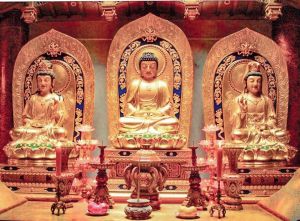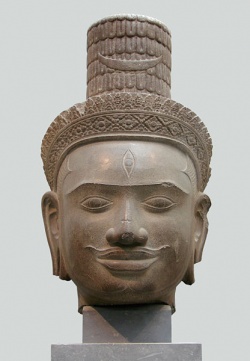Third eye
The third eye (also known as the inner eye) is a mystical and esoteric concept referring to a speculative invisible eye which provides perception beyond ordinary sight.
In certain dharmic spiritual traditions such as Hinduism, the third eye refers to the ajna, or brow, chakra.
In Theosophy it is related to the pineal gland. The third eye refers to the gate that leads to inner realms and spaces of higher consciousness.
In New Age spirituality, the third eye often symbolizes a state of enlightenment or the evocation of mental images having deeply personal spiritual or psychological significance.
The third eye is often associated with religious visions, clairvoyance, the ability to observe chakras and auras, precognition, and out-of-body experiences. People who are claimed to have the capacity to utilize their third eyes are sometimes known as seers.
Characteristics
In some traditions as Hinduism the third eye is said to be located around the middle of the forehead, slightly above the junction of the eyebrows. In other traditions, as in Theosophy, it is believed to be connected with the pineal gland.
According to this theory, humans had in far ancient times an actual third eye in the back of the head with a physical and spiritual function.
Over time, as humans evolved, this eye atrophied and sunk into what today is known as the pineal gland. Dr. Rick Strassman has controversially suggested that the pineal gland, which maintains light sensitivity, is responsible for the production and release of DMT (dimethyltryptamine), a psychedelic drug which he believes to be excreted in large quantities at the moments of birth and death.
In religion
Hindu tradition associates the third eye with the sahasrara, or crown, chakra. Also, in the Tantra yoga system it is associated with the sound Om, and is known as the Ajna chakra.
In Tantra, the crown is believed to be the Shivatic lotus of ten thousand petals.[citation needed]
In Taoism and many traditional Chinese religious sects such as Chan (a cousin to the Zen school), "third eye training" involves focusing attention on the point between the eyebrows with the eyes closed, and while the body is in various qigong postures.
The goal of this training is to allow students to tune in to the correct "vibration" of the universe and gain a solid foundation on which to reach more advanced meditation levels.
Taoism teaches that the third eye, also called the mind's eye, is situated between the two physical eyes, and expands up to the middle of the forehead when opened.
Taoism claims that the third eye is one of the main energy centers of the body located at the sixth chakra, forming a part of the main meridian, the line separating left and right hemispheres of the body.
According to the Christian teaching of Father Richard Rohr, the concept of the third eye is a metaphor for non-dualistic thinking; the way the mystics see.
In Rhohr's concept, mystics employ the first eye (sensory input such as sight) and the second eye (the eye of reason, meditation, and reflection), "but they know not to confuse knowledge with depth, or mere correct information with the transformation of consciousness itself.
The mystical gaze builds upon the first two eyes—and yet goes further."
Rohr refers to this level of awareness as "having the mind of Christ".
According to the neo-gnostic teachings of Samael Aun Weor, the third eye is referenced symbolically and functionally several times in the Book of Revelation 3:7-13, a work which, as a whole, he believes describes Kundalini and its progression upwards through three and a half turns and seven chakras.
This interpretation equates the third eye with the sixth of the seven churches of Asia detailed therein, the Church of Philadelphia.
Adherents of Theosophy H.P. Blavatsky have suggested that the third eye is in fact the partially dormant pineal gland, which resides between the two hemispheres of the brain. Various types of lower vertebrates, such as reptiles and amphibians, can actually sense light via a third parietal eye—a structure associated with the pineal gland—which serves to regulate their circadian rhythms, and for navigation, as it can sense the polarization of light.
C.W. Leadbeater claimed that by extending an "etheric tube" from the third eye, it is possible to develop microscopic and telescopic vision.
It has been asserted by Stephen Phillips that the third eye's microscopic vision is capable of observing objects as small as quarks.
According to Max Heindel's Rosicrucian writings, called Western Wisdom Teachings, the third eye is localized in the pituitary body and the pineal gland. It was said that in the far past, when man was in touch with the inner worlds, these organs were his means of ingress thereto.[citation needed]
Other interpretations
The third eye is a concept found in many meditation schools and arts, such as in yoga, qigong, Aikido.
In the esoteric discipline of Kabbalah, the Ajna chakra is attributed to the sphere of Ḥokhmah, or Wisdom, although others regard the third eye as corresponding to the non-emanated sephirah of da'ath (knowledge).

